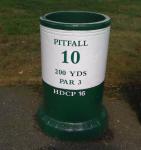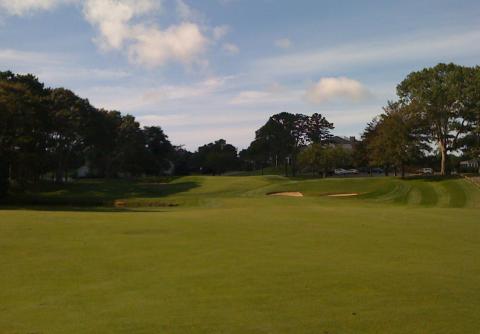"Drink it," your mother used to say. "It's good for you." She was right, of course, but it tasted awful. That's a little like the way I feel about one of my favorite golf courses ever, Oyster Harbors. Your score may leave a lousy taste in your mouth, but the experience is good for you and your golf game.
I was invited to the 28th annual Fall Frolic at Oyster Harbors Golf Club in Osterville, MA. The company of 46 fellow golfers, many of them from the Hartford (CT) Golf Club, the gentlemanly stewardship of Frolic organizer Dick Farr, the perfect fall weather, and the classic, stunning golf course made for two days of sheer delight. As we teed off in balmy weather this morning, I was tempted to ask my golfing partner, "Is this heaven?" "Nah," he most likely would have responded, "it's just Oyster Harbors."
I know what you're thinking. This kind of sentimentality is unbecoming of someone who touts his objectivity about the courses he plays and reviews.
Oyster Harbors is both fair and, at
times, brutal. There is not a
single out of bounds stake on the course...or on the entire surrounding
island. Skitter your shot across a
road onto someone's front yard, and go ahead and take your swing. I played one from beside a row of
hedges on one hole and saved a couple of strokes. The course's generous fairways keep you in the game off most
tees, and the amply endowed greens are typically wide and inviting also. But like an old fool smitten by a young
beauty, be careful what you wish for when you go at the pin. Once you arrive greenside, vertigo can
set in. As one of the presenters
at dinner remarked, if you have not played Pinehurst #2, a tour around Oyster
Harbors gives you a good idea of what that is like.
someone's front yard, and go ahead and take your swing. I played one from beside a row of
hedges on one hole and saved a couple of strokes. The course's generous fairways keep you in the game off most
tees, and the amply endowed greens are typically wide and inviting also. But like an old fool smitten by a young
beauty, be careful what you wish for when you go at the pin. Once you arrive greenside, vertigo can
set in. As one of the presenters
at dinner remarked, if you have not played Pinehurst #2, a tour around Oyster
Harbors gives you a good idea of what that is like.
No chip shot is straight to the hole, and neither are virtually all the putts. Just a couple of greens are severely elevated, but most have false fronts and, in too many cases when you forget to play short, you'll be faced with false backs as well. Short is always better than long at Oyster Harbors, and on most holes I preferred a 20-yard pitch shot up to the hole to a 30-foot putt from pin high. None of the breaks on the greens are dramatic like, say, from rear right to the final-day pin position at The Masters. But every putt at Oyster Harbors from outside three feet must be worked over, looked at from all angles and never ever taken for granted.
Oyster Harbors can pick you up and drop you down, and not necessarily in that order. I was despondent after I carded an 8 on the par 4 9th on our first day (we started at #5). But generously wide fairways beckoned on the following holes, and I am an okay putter, and my partner was counting on me to snap back. I carried an 11 handicap into my rounds at Oyster Harbors, shot 86 and 84 and thought I played those two rounds better than any others in the last year. The 86 included the snowman, and the 84 included four missed putts from inside five feet, but that was not because I over-read or under-read any of them. It was more the worry about the following putt if I missed and whether a too-aggressive stroke would result in a three putt from five feet. (Two of my three playing partners today, also 11 handicappers, four putted.) If you worry about the following putt before you stroke a five-footer, you will surely miss.
But Oyster Harbors is good for your golf game. The green complexes force you to think on every approach shot and, in many cases, to dial back your notions about getting the ball to the hole from 150 yards away. When the wind kicked up today, I was channeled back to Scotland, where punch shots into or beneath the wind work best. Thirty feet below the hole is much better than 10 feet above. Great golf courses challenge and teach and revise our laziest notions about the game.
Note: In a month, Tom Doak will commence some tweaking of all the holes at Oyster Harbors. Doak has great respect for the classic architects and their work, and he likely will do no harm. But how do you improve on heaven? If I am lucky enough to be invited back next year -- Oyster Harbors is private -- I will let you know how the tweaking worked out.

The dogleg right 9th at Oyster Harbors is one of the few that features a water hazard. But the customary Ross bunkers and elevated green are more worrisome, especially into the prevailing winds.



